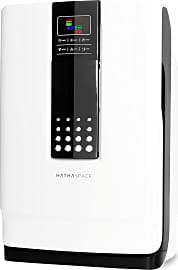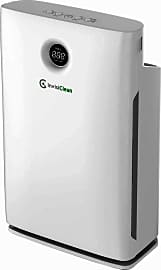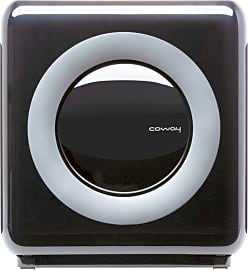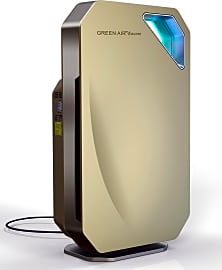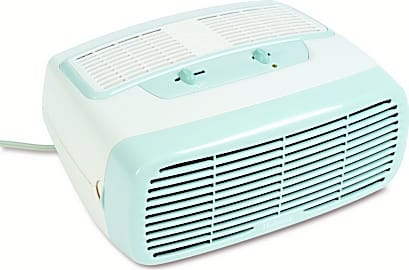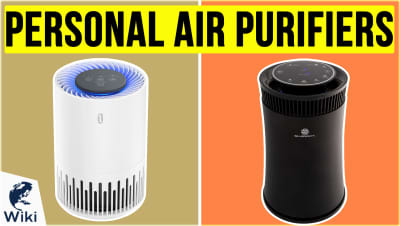The 10 Best Air Ionizers

This wiki has been updated 38 times since it was first published in June of 2015. If you've been suffering from allergies and sinus issues, your home's air quality may be to blame. These ionizers charge bacteria and other particles in the atmosphere, causing them to stick to the floor or other surfaces, where they can be vacuumed up and removed. You'll be amazed at how much easier it is to breathe with one of these things in your house, and they help neutralize odors, to boot. When users buy our independently chosen editorial choices, we may earn commissions to help fund the Wiki.
Editor's Notes
January 28, 2021:
Breathing clean air is important to one's health, and these ionizers are a smart way to help minimize the pollutants, dust, pet dander, and other contaminants floating around your home. They differ from standard air purifiers in that they release electrically charged negative ions that are said to bind with the positive ions carrying dust and other particulate, resulting in them being easier to trap in filters and also more likely to settle on the ground and walls rather than float through the air. During this update we added the Hathaspace HSP001 because of its hands-off approach that allows you to set it on auto mode, at which point it will operate autonomously when there are too many pollutants in the room. We also added the Oion Technologies B-1000, which utilizes UV sterilization, for those who are looking not just to trap bacteria, but also kill it too. However, it is worth noting that this model doesn't offer HEPA filtration. If you have a bit more cash to spend, you can opt for the InvisiClean Claro IC-4524, which offers both UV sterilization and HEPA filtration.
January 03, 2020:
During this busy round of updates, several of our previous rankings needed to be removed due to availability issues, including the Best Choice SKY1057, Breathe Fresh Air, HomeLabs 3-in-1 and Rigoglioso Portable. In their place, we’ve added several great new options including the Medify Air MA-40, which is equipped with a medical-grade, H13, HEPA filter and slick tempered-glass touch panel; the Blueair Blue Pure 211, a fun model that can be dressed up in one of five colored pre-filters; and the InvisiClean Claro IC-4524, which is outfitted with a built-in thermometer and humidistat, plus a short-wavelength ultraviolet light that’s ready eradicate harmful microorganisms via irradiation.
A few things to think about to help you filter your choices for this category:
Clean-Air Delivery Rate: Simply put, clean-air delivery rate (CADR) is the speed at which a given unit can completely clean all the particulates of a given size out of the air. Measured in cubic feet per minute (CFM), and devised by the Association of Home Appliance Manufacturers, the idea behind CADR is to allow consumers the opportunity to compare apples to apples when assessing purchase options. This can be nice, as there is often a lack of transparency from companies when it comes to understanding just how they concluded what size of room their machine is suitable for.
Filter Systems: While this wiki is dedicated to air ionizers, many of the machines we ranked are in fact air purifiers with complex filtration systems, meaning that air ionization is only one step of the challenging gauntlet they put particles through. Common three-stage filtration systems – like the one employed by the Green Air Encore KH-H201 – move air through a pre-filter, to sift out larger airborne particulates; then through an activated carbon filter; to remove unpleasant (or really any) odors; and finally, through a HEPA filter, which is responsible for catching most of the harmful micro-organisms and allergens moving through it, before finally passing whatever’s left to its air ionizer. While most of our top-ranked items involve some sort of HEPA filter, a tip of the hat goes to the Medify Air MA-40, which employs an H13, HEPA filter, which is the second-most-effective classification of HEPA filter available (H14 trumps it).
Aesthetics: Needless to say, we’re talking about appliances and not art installations, but with several nicely-designed options available in the category, there’s no reason to walk away with something you think looks awful. Two models we ranked that stand out as being particularly stylish are the Allen BreatheSmart Pure and the Blueair Blue Pure 211. While the former has eight available front panels, offering everything from metallic styles to wood-grain looks, the latter has five, colored pre-filters available, and would look right at home next to a Google Home speaker.
How Does An Air Ionizer Work?
Ions with more electrons will be negatively charged, and are called anions.
Within an atom there exists a microscopic act of homeostasis. Protons within the nucleus maintain a positive charge, while neutrons have a neutral charge. The electrons which spin around the nucleus have a negative charge; and it is the electrical energy created by the orbiting electrons being attracted to the protons which keeps the atom together.
Most atoms exist in this normal state. However, atoms may move from this normal state to an ionic state by losing or gaining an electron. In general, atoms are always looking to complete their electron valence shell, and will be attracted to particles which allow them to do so. This is known as the octet rule.
Ions typically form when metal atoms react with nonmetal atoms, creating either a shortage or overage of electrons in their structure. If an ion has more protons than electrons, it is considered a cation, which has a positive charge. Ions with more electrons will be negatively charged, and are called anions. These ions form as a result of chemical reactions, combustion, and radiation.
Air ionizers inject ions into the air which can then react with air pollutants; making them inactive in our bodies. Most do this through creating a corona discharge. This discharges free electrons into the surrounding air, which quickly latch on to the nearest air molecule, turning it into an ion. Because these ions will naturally repel each other, a relatively large area of effect is observed without the need for external fans. These ions then attach themselves to air pollutants, which have relatively large molecules. The new molecules will then seek to ground themselves through contact with a wall or floor, where they can be easily wiped away.
What Are The Health Benefits Of Air Ionizers?
The health benefits of using air ionizers come from the introduction of negative ions into the environment and therefore our body system. The highly reactive electrons in negative ions are constantly looking to link up with other atoms; and as they find them, the reactivity of the ion dissipates.
Studies have also reported the ability of negative ions to reduce serotonin irritation syndrome; which is a state of anxiety caused by a rise in positive ions in the air.
Our ancestors picked up negative ions by walking barefoot on the Earth itself. Earth has a negative charge, and humans who walk upon the Earth's bare surface pick up these negative ions through a process now known as earthing. There are many benefits to this practice alone, including reduction of free radicals in the body, better sleep, lowered stress levels and heart rate, and even physiological factors such as increased mood.
Luckily, the same negative ions which we absorb from the earth can also be created in any environment where there is an air ionizer. Inhaling negative ions may reduce overall feelings of depression, especially at high concentrations. Increased exposure to negative ions has also been associated with lowered psychological stress, reduced feelings of anxiety, and a general enhanced feeling of well-being.
Studies have also reported the ability of negative ions to reduce serotonin irritation syndrome; which is a state of anxiety caused by a rise in positive ions in the air. When volunteers were exposed to increased ambient positive ions, they were found to have increased anxiety, excitement, and feelings of suspicion. Volunteers were then exposed to negative ions, and the results were astounding. Not only did the exposure to negative ions reduce the states caused by positive ions; they also lowered them to more reduced states than their normal levels.
The Difference Between Positive And Negative Ions
Simply put, an ion is an atom which has gone through a certain chemical bond; resulting in the atom either having lost or gained an electron. As electrons in an atom are negatively charged, atoms which have an extra electron are negatively charged, whereas atoms with a missing electron are positively charged. The addition or subtraction of an electron also make the atom highly reactive; and the atoms are constantly seeking to balance themselves back out by linking up with another atom.
As electrons in an atom are negatively charged, atoms which have an extra electron are negatively charged, whereas atoms with a missing electron are positively charged.
While both positively charged ions and negatively charged ions exist in the natural world, it is the modern era which is responsible for a large number of positive ions collecting in the atmosphere. Byproducts from heavy machinery, vehicles, electronics, and manufacturing all contribute to the growing levels of positive ions and ultra-fine particles; with air pollution being the greatest factor.
In the natural world, the charge is slightly more positive. This may be due to the fact that Earth itself carries a negative charge which repels other negative particles. The effects of positive ions can be felt in nature in the moments before a storm. When people complain of their joints aching just before a storm, they are simply noting the inflammatory effects of positive ions in the air; which take a sharp spike upwards before a storm.
The effects of negative ions can be felt on a hike through the woods. The abundance of oxygen and the moisture-rich soil combine to create a negative ion bath which results in increased mood and calmness. Negative ions have a positive effect on the health rather than a negative one; reducing inflammation and lowering stress.


